Optogenetic modulation of TDP-43 oligomerization accelerates ALS-related pathologies in the spinal motor neurons
- PMID: 32081878
- PMCID: PMC7035286
- DOI: 10.1038/s41467-020-14815-x
Optogenetic modulation of TDP-43 oligomerization accelerates ALS-related pathologies in the spinal motor neurons
Abstract
Cytoplasmic aggregation of TDP-43 characterizes degenerating neurons in most cases of amyotrophic lateral sclerosis (ALS). Here, we develop an optogenetic TDP-43 variant (opTDP-43), whose multimerization status can be modulated in vivo through external light illumination. Using the translucent zebrafish neuromuscular system, we demonstrate that short-term light stimulation reversibly induces cytoplasmic opTDP-43 mislocalization, but not aggregation, in the spinal motor neuron, leading to an axon outgrowth defect associated with myofiber denervation. In contrast, opTDP-43 forms pathological aggregates in the cytoplasm after longer-term illumination and seeds non-optogenetic TDP-43 aggregation. Furthermore, we find that an ALS-linked mutation in the intrinsically disordered region (IDR) exacerbates the light-dependent opTDP-43 toxicity on locomotor behavior. Together, our results propose that IDR-mediated TDP-43 oligomerization triggers both acute and long-term pathologies of motor neurons, which may be relevant to the pathogenesis and progression of ALS.
Conflict of interest statement
A patent application covering this work (application no. JP2018-186569, PCT/JP2019/037829) has been filed in which Inter-University Research Institute Corporation Research Organization of Information and Systems, and K.A. and K.K. are the inventors.
Figures
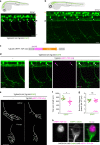

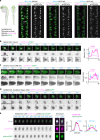
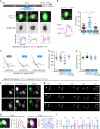
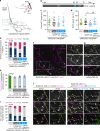
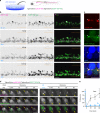
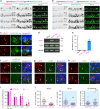

Similar articles
-
[Optogenetic interrogation of TDP-43 cytotoxicity in a zebrafish ALS model].Nihon Yakurigaku Zasshi. 2023;158(1):16-20. doi: 10.1254/fpj.22085. Nihon Yakurigaku Zasshi. 2023. PMID: 36596480 Review. Japanese.
-
A robust TDP-43 knock-in mouse model of ALS.Acta Neuropathol Commun. 2020 Jan 21;8(1):3. doi: 10.1186/s40478-020-0881-5. Acta Neuropathol Commun. 2020. PMID: 31964415 Free PMC article.
-
Optogenetic Phase Transition of TDP-43 in Spinal Motor Neurons of Zebrafish Larvae.J Vis Exp. 2022 Feb 25;(180). doi: 10.3791/62932. J Vis Exp. 2022. PMID: 35285826
-
Distinct responses of neurons and astrocytes to TDP-43 proteinopathy in amyotrophic lateral sclerosis.Brain. 2020 Feb 1;143(2):430-440. doi: 10.1093/brain/awz419. Brain. 2020. PMID: 32040555 Free PMC article.
-
The molecular link between inefficient GluA2 Q/R site-RNA editing and TDP-43 pathology in motor neurons of sporadic amyotrophic lateral sclerosis patients.Brain Res. 2014 Oct 10;1584:28-38. doi: 10.1016/j.brainres.2013.12.011. Epub 2013 Dec 16. Brain Res. 2014. PMID: 24355598 Review.
Cited by
-
RNA granules in flux: dynamics to balance physiology and pathology.Nat Rev Neurosci. 2024 Nov;25(11):711-725. doi: 10.1038/s41583-024-00859-1. Epub 2024 Oct 4. Nat Rev Neurosci. 2024. PMID: 39367081 Review.
-
Multi-phaseted problems of TDP-43 in selective neuronal vulnerability in ALS.Cell Mol Life Sci. 2021 May;78(10):4453-4465. doi: 10.1007/s00018-021-03792-z. Epub 2021 Mar 11. Cell Mol Life Sci. 2021. PMID: 33709256 Free PMC article. Review.
-
Establishment of chemically oligomerizable TAR DNA-binding protein-43 which mimics amyotrophic lateral sclerosis pathology in mammalian cells.Lab Invest. 2021 Oct;101(10):1331-1340. doi: 10.1038/s41374-021-00623-4. Epub 2021 Jun 15. Lab Invest. 2021. PMID: 34131277
-
RNA-binding proteins as a common ground for neurodegeneration and inflammation in amyotrophic lateral sclerosis and multiple sclerosis.Front Mol Neurosci. 2023 Jul 4;16:1193636. doi: 10.3389/fnmol.2023.1193636. eCollection 2023. Front Mol Neurosci. 2023. PMID: 37475885 Free PMC article. Review.
-
Optogenetic induction of TDP-43 aggregation impairs neuronal integrity and behavior in Caenorhabditis elegans.Transl Neurodegener. 2025 Apr 16;14(1):20. doi: 10.1186/s40035-025-00480-x. Transl Neurodegener. 2025. PMID: 40234916 Free PMC article.
References
Publication types
MeSH terms
Substances
LinkOut - more resources
Full Text Sources
Other Literature Sources
Medical
Molecular Biology Databases
Research Materials
Miscellaneous

